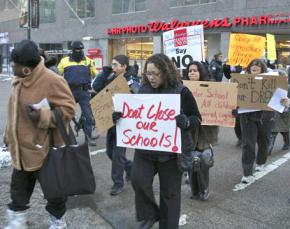Resisting the school-closing agenda
looks at the battle over public school closures and education "reform" in Chicago, New York City and Los Angeles.
UNELECTED SCHOOL boards in Chicago and New York will get an earful--and more-- from teachers, parents and community activists December 14 in protests against planned school closures and charter school expansion.
In Los Angeles, school officials are apparently bucking the trend, agreeing to a moratorium on closures and new charter schools. But in return, the authorities are demanding that union members agree to vote on sweeping "reforms" at individual schools that would implement charter-style working conditions across the entire system.
The hot spot in the battle over charter school expansion and school closings fight remains Chicago. Twelve new charters schools will be added next year, while 10 traditional public schools will be closed or phased out.
School closures were first launched in Chicago in the 1990s in the first phase of corporate-style "school reform." In the latest version, Mayor Rahm Emanuel and his operative, Schools CEO Jean-Claude Brizard, propose closing for phasing out 10 schools, firing every single school employee in the process.

Six of the schools will be turned over to the Academy for Urban School Leadership (AUSL). AUSL is a politically connected nonprofit whose former board member is now president of the Chicago Board of Education. In the 19 Chicago public schools run by AUSL, teachers remain employees of the school board and members of the union--but teachers fired in the "turnarounds" have no guarantee of keeping their jobs.
According to Chicago Teachers Union President Karen Lewis, the closure move and the handover of schools to AUSL wasn't surprising, given the organization's connections to the Chicago political establishment. But AUSL schools are hardly a model of reform, she said. "They benefit when the schools around them close," Lewis said. "They go over to those schools, look at the test data and invite those kids with the highest test scores to come to their schools. So what you see is an amazing increase in what AUSL has done."
Meanwhile, the expansion of charter schools comes despite a recent study showing that charters in Chicago have, at best, a mixed record of performance--and in many cases trail traditional public schools' test scores.
"Charter schools, which are supposed to be hotbeds of innovation, have no innovation in curriculum and no innovation in instruction," Lewis said. "The only innovation has been in the labor-management relationships"--that is, operating without a union.
In response to the school closings, CTU members and community allies will camp out all night December 13 to be able to sign up to speak at the school board meeting the following morning--and they're prepared to take over the meeting if the board refuses to heed their voices.
The planned action took shape following a December 3 CTU-sponsored labor-community meeting of 500 teachers, parents and community allies to mobilize against the Chicago Board of Education plan to close, phase out or "turn around" 10 schools.
At the meeting, teachers and parents from 90 schools, along with a range of community organizations and activists, strategized about how to save individual schools. The experience of the Occupy movement was a key topic of discussion--and the tactic isn't new to Chicago Public Schools' (CPS), where parents at Whittier School earlier this year occupied a school annex building in a successful effort to prevent its demolition.
When schools are targeted for closure, the only alternative is to "figure out how to be a pain in the ass," said Matt Farmer, an attorney active in the Whittier struggle and author of a recent article chronicling CPS policy twists and turns at Dyett High School on the South Side, one of the schools slated for closure under CPS's plans.
A former middle school turned into a high school more than a decade ago to accommodate displaced students from a new selective enrollment high school, Dyett will disappear if Brizard and Emanuel get their way.
The plan to close Dyett doesn't surprise Jitu Brown of the Kenwood-Oakland Community Organization (KOCO). A veteran activist against gentrification and a member of Dyett's Local School Council, Brown has been fighting to get additional resources to the school's predominately low-income students, almost all of them African American.
Now Dyett's students will be shuffled off to new schools on the South Side--but they won't be safe from further disruptions, Brown said:
These are transitional schools as they continue to push us out of the neighborhood. A common denominator in every reform that CPS has done since 1995 has been that they locked the voices of parents and the community out. We tie it to a gentrification agenda, we tie it to a racist agenda. We feel like the voices of parents and the people most directly impacted are not respected.
A SIMILAR school closure agenda is unfolding in New York City, where the Department of Education recently announced the closing or downsizing of 25 schools.
Along with the shutdown in the name of reform comes the expansion of charter schools. Brian Jones, a fourth-grade teacher at PS 261 in Brooklyn and activist with the Grassroots Education Movement (GEM), described how politically connected charter operator Eva Moskowitz of the Harlem Success Academy is bypassing the normal authorization process to land a charter in Brooklyn's wealthy and gentrifying neighborhoods:
She's already started dumping thousands of glossy, full-color brochures all over Cobble Hill. She's got flunkies handing them out around the corner from my school in Boerum Hill...The upshot is that she did an end-run around legal procedure to get herself in some prime real estate--the leafy, brownstone part of Brooklyn is now going to give her free space and huge cache.
The United Federation of Teachers (UFT) opposes the school shutdowns, but has rarely mobilized to stop them. That effort has been taken up by groups like GEM and Occupy the DOE, a working group from Occupy Wall Street that shut down Mayor Michael Bloomberg's handpicked Public Education Panel (PEP) at a recent meeting. And on November 29, GEM and various community groups organized a protest against Moskowitz's Brooklyn expansion plan.
Now GEM, Occupy the DOE and other groups are set to repeat the "mic check" of the October PEP meeting.
To try to avoid protesters opposed to school closings and Moskowitz's Brooklyn charter plans, the PEP moved its meeting from Manhattan to an out-of-the-way high school in Queens. But activists plan to be there in solid numbers anyway.
While the PEP closure list targets only a small minority of the nearly 1,000 total schools in New York City, the impact will be felt by teachers and students whose schools are on the watch list, but are spared from a shutdown. That's because even the appearance of a school on a list of possible closings can force teachers into special evaluation programs.
In New York, as in many other states, new legislation passed to compete for the federal Race to the Top grant money imposes a punitive new teacher evaluation scheme, one of which is being piloted in some New York City schools. "So even for schools on the watch list that don't get closed down, there is increased scrutiny of teachers," said a teacher at a Queens high school.
While the stated aim of such measures is to help improve teaching performance, the result is to give principals greater leverage over teachers and make it easier to get rid of them. That's certainly the intention of Bloomberg, who recently stated that he wishes he could fire half the city's teachers to create a more quality workforce. Since he can't get away with that, he's making sure principals have the tools to terminate teachers more easily.
EMPOWERING PRINCIPALS to carry out "reform" on a school-by-school basis is also the logic of the agreement between the Los Angeles Unified School District (LAUSD) and United Teachers Los Angeles (UTLA).
The agreement, to be voted by union members this week, freezes the number of charter schools for three years and bars school closures over the same period. That's seemingly a big reversal of LAUSD's Public School Choice initiative, which sought to fast-track takeovers of schools by charters or other entities. UTLA pushed back by writing their own school reform plans in alliance with parent groups, which voted to approve those changes.
But a closer look shows that LAUSD is out to achieve the same end--the evisceration of the UTLA contract--by different means. The proposed agreement between the district and union negotiators led by a new president, Warren Fletcher, will allow individual schools to vote in separate agreements that will supersede the collective bargaining agreement on almost every issue but pay and benefits.
The deal--which comes after the union agreed to continued pay cuts through furlough days in June--is opposed by Progressive Educators for Action (PEAC). As Gillian Russom, UTLA's East Area chair, wrote, "A big reason why we have a collective bargaining agreement is that teachers in individual schools aren't strong enough to fight for their rights alone."
If the agreement is ratified, LA teachers may find their bargaining unit numbers protected in the short term, but at the cost of being pressured to surrender decades of bargaining achievements on a school-by-school basis.
The agreement, promoted by LAUSD Schools Superintendent John Deasy, shows that the corporate school "reform" agenda is more sophisticated than a smash-and-grab privatization scheme in which public schools are closed and replaced by charters.
There will be plenty more of such attacks, if the reformers have their way. But their central aim is to nullify the bargaining power and organizational might of the teachers unions. If school principals in LA can achieve this by getting teachers to vote to approve "thin" contracts stripped of job protections, that's good enough.
In fact, the focus on "empowering" principals is shared by both Deasy and Chicago's Brizard. Both are graduates of the Broad Foundation's training school for school district chiefs. And one of Brizard's first acts since taking over earlier this year was to call CPS's first-ever meeting of all principals across the system. The message was clear: Principals had to show improvement in school scores, or else. The principals, in turn, will be out hunting for "bad teachers."
Thus, the stage is set for school-site showdowns in which teachers' unions will have to organize at the chapter level.
Grassroots organizing around such issues has been a focus for the CTU in Chicago, where Mayor Rahm Emanuel revoked a 4 percent race due to the union earlier this year. Emanuel also arm-twisted the state legislature to sharply limit the CTU's right to strike, imposing a months-long negotiation and mediation process before the union can legally walk the picket line.
But while such a confrontation may be delayed, it increasingly appears inevitable as the union mobilizes its membership and allies, and Emanuel ramps up his attacks.
The fight over school closures, then, is a prelude to a bigger battle to come. As the school boards in New York and Chicago prepare to vote in early 2012 on which schools to shut down, the resistance will continue to grow.



